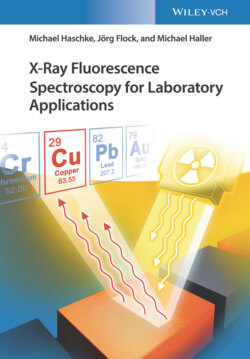Читать книгу X-Ray Fluorescence Spectroscopy for Laboratory Applications - Michael Haschke, Jörg Flock - Страница 17
2.2.4.1 Absorption
ОглавлениеAbsorption will be understood merely as the attenuation of the incident X-ray radiation by the ionization of atoms. This process is described by the element- and energy-dependent photoionization coefficient. It increases with higher atomic number and decreases with increasing energy as can be seen in Figure 2.5. This energy dependence can be approximated by τ ≈ E−3. The curve does show discontinuities that manifest themselves as jumps. They occur when the energy of the absorbed radiation is sufficient to ionize a new electron shell, i.e. a new interaction mechanism is added. In the diagrams in Figure 2.5, this applies to Pb for the excitation of M, L, and K radiation at energies of approximately 3, 15, and 88 keV, respectively. The energy of the K-absorption edge of C, on the other hand, is 0.283 keV and is therefore not displayed in the diagram.
Table 2.2 Comparison of line designations for the main X-ray lines.
| Siegbahn | IUPAC | Siegbahn | IUPAC | Siegbahn | IUPAC |
|---|---|---|---|---|---|
| Kα1 | K–L3 | Lα1 | L3–M5 | Mα1 | M5–N7 |
| Kα2 | K–L2 | Lα2 | L3–M4 | Mα2 | M5–N6 |
| Kß1 | K–M3 | Lß1 | L2–M4 | Mβ | M4–N6 |
| Kß2 | K–N3 | Lß2 | L3–N5 | Mγ | M3–N5 |
| Kß3 | K–M2 | Lß3 | L1–M3 | Mξ | M4,5–N2,3 |
| Kß4 | K–N5,4 | Lß4 | L1–M2 | ||
| Kß5 | K–M4,5 | Lß5 | L2–O4,5 | ||
| Lß6 | L3–N1 | ||||
| Lγ1 | L2–N4 | ||||
| Lγ2 | L1–N2 | ||||
| Lγ3 | L1–N3 | ||||
| Lγ4 | L1–O3 | ||||
| Lγ5 | L2–N1 | ||||
| Lγ6 | L2–O4 | ||||
| Lη | L2–M1 |
Figure 2.5 Contributions to the attenuation coefficient for X-radiation of (a) carbon and (b) lead.
